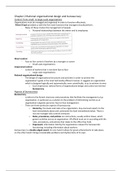Chapter 2 Rational organizational design and bureaucracy
Control: from small- to large-scale organizations
Organizations must be managed and organized in order to function effectively
Henri Fayol provided us with the five main functions that managers should perform.
- Many of these involve the management of people
o Personal relationships between the owner and its employees
Direct control
- Face to facr control of workers by a manager or owner
o Small scale organizations
Impersonal control
- Control of workers that is not done face to face
o Large scale organizations
Rational organizational design
- The design of organizational structures and activities in order to achieve the
organization’s goals in the most technically efficient manner. It suggests an organization
which is designed logically and systematically, even scientifically, so as to achieve its aims
o Such impersonal, rational forms of organizational design and control are termed
bureaucracy
Aspects of bureaucracy
Bureaucracy
- It refers to the formal structures and procedures that facilitate the management of an
organization, in particular as a solution to the problem of diminishing control as an
organization outgrows personal, face-to-face management.
- There are three particular aspects of bureaucracy:
o Hierarchy, the levels and ranks of an organization. Any one level reports to the
level immediately above and commands the level immediately below. There is
not one manager who controls everyone.
o Rules, procedures, and policies are instructions, usually written down, which
govern activities across an organization. All official must act in according with the
rules, procedures, and policies that relate to the office they hold.
o Paperwork, information held by the organization relevant for bureaucratic
functioning, including information about workers.
bureaucracy is a double-edged sword. On one hand it allows for great achievements to take place,
on the other hand it brings considerable problems and dysfunctions of its own.
,Bureaucratic structure and hierarchy
There’s an official structure or hierarchy. It
develops as a response to the problem of
maintaining control over people in an
organization as it grows in size.
Span of control
- the number of workers controlled
by a manager at any one particular
level in a hierarchy
Delegate
- to pass a job, task, or order down
to lower levels of a hierarchy. You
get more managers who control
small groups of employees.
Organizational structure
- the roles and positions in an organization, often organized horizontally and vertically in
the form of an organization chart diagram
Vertical and horizontal differentiation
Vertical differentiation
- the process whereby a hierarchy creates a number of different layers of management
within an organization
o Employees are separated and differentiated vertically from one level of the
hierarchy to the next
Horizontal differentiation/functional differentiation
- the process whereby different parts of the hierarchy are grouped according to criteria,
such as the function performed, the geographical area served, or the product or service
provided.
Roles and relationships
An official a person who fills a particular role in an organization. When working in that role, a
person is said to be working in an official capacity
Job description
- a document which outlines the formal duties and activities that the holder of a particular
office will be expected to perform, and their place within the overall organizational
structure.
Bureaucratic standardization-rules, policies, and procedures
Bureaucratic structure is supplemented and enhanced by another aspect of hierarchy: rules,
policies, and procedures.
- Standardizing behaviours and activities throughout an organization, such that the
control is implemented in the same way at all levels up and down the hierarchy.
- Formal instructions that govern how particular activities in an organization are to
be performed. standardize aspects of workplace control
Discretion
- The ability of an individual to act according to their own independent judgement, rather
than being told exactly what to do.
Human resource management (HRM) The part of an organization that concentrates on policies
and procedures relevant to the management of people within the organization (personnel
management).
,Bureaucratic records and paperwork
Paperwork the final aspect of bureaucracy.
- Official documentation and record keeping within an organization.
Paperwork is typified by the pro-forma
- A type of paperwork, sometimes called a form. It is a blank template with standard fields
for different types of relevant information, which is filled in as a means of capturing
information for the records of an organization.
There are two purposes for the record keeping for the management:
- Standard record keeping is needed
- Each employee is allocated with a number
Fayol, bureaucracy, and the principles of management
Classical management school a set of theories of management which draws upon rational
methods of managing and organizing
Fayol’s list of the important management principles because these helped efficient management
and control:
- A division of roles where all tasks are specialized (as with vertical and horizontal
differentiation, creating specific roles within the organization
- Unity of command where each worker answers to only one manager, not several
- Centralization, with delegation down through the ranks
- Equity of treatment for all employees, as seen with rules and procedures
- Order, everything to be in the right place at the right time, as seen with timetables
- Subordination of interests, individual interests are secondary to those of the organization
as a whole.
Weber and the critique of bureaucracy
Max Weber appreciated the power and efficiency of bureaucracy, but was also aware of the
increasing dominance and negative aspects within the society.
Rational-legal authority
- According to Max Weber this is power that is legitimated by rules and procedures
associated with an office rather than by traditional or charismatic means.
o Authority is not from tradition nor from an individual, but from the authority
they have due to the office they hold.
He outlined features of an ideal type of rational, technically efficient bureaucracy:
- Functional division of labour (horizontal differentiation)
- Hierarchical structure (vertical differentiation)
- Rules and regulations
- Impersonality, the separation of working lives from personal lives
- Unbiased decision making, including recruitment, selection, and promotion
, Formal and substantive rationality
Formal rationality
- technically efficient means of achieving particular ends without thinking of the human or
ethical consequences
Substantive rationality
- rationality from a human and ethical perspective, if something is formally rational and
efficient it does not make it substantively rational when considering its human and
ethical consequences.
Disenchantment
- for Max Weber this was a loss of magical elements in society. And suggests some of the
dehumanizing elements of bureaucracy
the iron cage of bureaucracy
- Max Weber’s observation of the increased presence of bureaucracy in society and its
potential to trap people in its routines and procedures
o Small, insignificant elements in a large-scale organization
Dysfunctions of bureaucracy
These are unintended consequences of bureaucracy which lead to it not functioning in the efficient
manner for which it is designed.
- Red tape
o An unintended consequence of bureaucracy. Where rules and paperwork get in
the way of work and activities, rather than helping tasks to be performed
efficiently.
- Bureaucratic personality
o A tendency to follow rules to the letter rather than seeing the wider picture and
making more common- sense judgements.
- Trained incapacity
o Where people are so used to their behaviour being controlled by bureaucratic
rules and procedures that they become inflexible and unable to think for
themselves and show initiative.
- Work to rule
o A form of industrial action where workers follow rules, regulations, and
instructions precisely. This often results in the speed of work slowing
considerably.
- Mock bureaucracy
o A situation where policies and rules exist, but are ignored.
Evaluating bureaucracy: a double-edged sword?
On one hand bureaucracy makes management and activity on a large scale possible that would
otherwise be beyond human capacity. On the other hand bureaucracy has negative aspects, both in
its dehumanizing effects upon people and its dysfunctions.
That most, if not all, organizations employ some form of bureaucracy is a testament to its undoubled
advantages:
- It not only allows for Fayol’s five aspects of management (planning, organizing,
commanding, coordination and control) to take place, but it allows for them to be done
efficiently on a large-scale.
- It solves the problem of keeping order within an organization as it grows in scale.
- It creates clear roles and responsibilities, outlining, clear lines of authority and the limits
of that authority.






